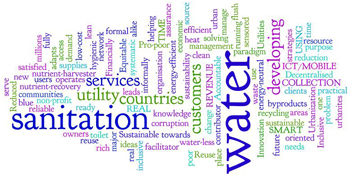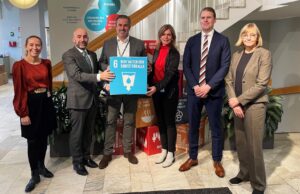The water and sanitation utility of the future
In December 2013 I went back to my old, beloved university, University of Luleå (LTU), for the 20th anniversary of Sanitary Engineering as a research subject at LTU. I was asked to give a presentation with sanitation and 2050 in mind, and I immediately knew that I wanted to talk about the water and sanitation utility of the future. I also immediately knew what I think are important corner-stones for a utility of the future.
So, there and then, I had my whole presentation together in five minutes… But I decided to take a step back, and ask friends, acquaintances and contacts within the sector what their first thought is when they hear “the water and sanitation utility of the future”, to get a sense of whether my immediate thoughts were matched with a tad larger sector thinking. I sent out that very question to about 100-120 people, more or less equally divided between Swedish and international colleagues, friends, acquaintances and sector contacts in my email address book. From the answers (approximately a third answered) I created word clouds, see the English one below1.

The pictures, even if ever so cool, did not turn out quite as clear as I wanted so at the presentation itself I found I needed to help show the patterns I, as the receiver of the answers, could actually see. For the international answers I found three main trends pertaining to service delivery outreach, organisation and the technology/environment: The utility of the future (i) provides sustainable services for all2, (ii) is efficient, financially stable, customer-oriented, and provides reliable and sustainable services3 and (iii) is an innovative, systematic problem solving energy and nutrient producer4. The input from the international sector colleagues thus provides a comprehensive picture of a future water and sanitation utility should achieve and is totally in line with my “dream utility thinking”.
Several international sector colleagues focused on the importance of innovation, which I would like to dwell somewhat further on. One utility colleague explained that he thought innovation absolutely key both for financial sustainability and for customer satisfaction. He also observed that most utilities tend to be risk averse with the result that methodologies stagnate and these utilities will ultimately find themselves surpassed by utilities that embrace innovation and new approaches. I think this is spot-on what we need for the future: innovative utilities, whether it comes to technology, financial management, or institutional set-ups.
So how is innovation fostered within utilities? Storbjörk and Söderberg (2003)5 has outlined some important pre-requisites for utility innovation: (i) active and responsibility-assuming stakeholders, (ii) common values between core stakeholders in terms of a shared world vision, shared goals and shared problem picture, (iii) legal framework and political support allowing innovative actions, (iv) shared risks and responsibilities, (v) access to resources, both monetary and knowledge, (vi) communication with users, and (vii) an arena for participation and conflict management. This may seem overwhelming at first sight but with the exception of legal framework, political support and access to resources, all of which are part of an enabling environment dependent on the society and policital support as a whole, all other points can be worked on within the utility and its stakeholders immediately, with minimum resources.
Utilities that go for an innovation approach will clearly be the winners in a future society, with universal, customer-oriented, efficient, sustainable, energy and nutrient producing access to sanitation. eThekwini Water and Sanitation in Durban, South Africa6 is an excellent example of an innovative utility already today.
As for the answers from the Swedish sector colleagues they strongly correlated to the international answers, focusing on organisational and environmental/recycling issues, but without the concern of universal access to services since that is not a burning issue in a Swedish setting. I was happy to see that innovation was also mentioned as a cornerstone for the utility of the future from some Swedish sector colleagues. Swedish utilities definitely have the enabling environment in place, with access to resources, legislation in place that supports innovation and space to take action so there should be no stopping Swedish utilities from avoiding technical and institutional stagnation and embracing an innovation approach to service delivery. Some interesting things do take place currently e.g. in Södertälje with blackwater treatment in Hölö, discussions of separate blackwater collection in H+ in Helsingborg, models for community treatment plants in Västervik, legal clarification on where and when water and wastewater jurisdictions should apply in areas with existing on-site systems7 etc but they are nevertheless surprisingly few, given the golden opportunity the Swedish wastewater sector has for innovation.
My suggestion to Swedish utilities is to start a utility innovation revolution, to be bold, take some risks, join hands with relevant stakeholders and to start making really good use of eg the VINNOVA “Innovation Procurement” funds set aside for meeting societal challenges8. From where I sit, with my sanitation glasses on, few things can be more fit for these funds than to invest in the development of innovative water and sanitation systems, fit to deliver customer-oriented, efficient, sustainable, energy and nutrient producing services in the future.
References:
- www.wordle.net/create
- Words like ”inclusive”, ”equitable”, ”pro-poor” and statements like ”sustainable services for all” and “strategies to serve rich and poor alike” came from several international sector colleagues.
- Most comments came on organisation, which underpins the utter importance of looking at institutions and organization when it comes to service delivery. “Accountable”, “assurance”, “efficient”, “utility that adapts to its customers in real time”, and “financially sustainable” were some of the inputs from sector colleagues. Other were concerned with the set-up of the utility and it was suggested from one sector colleague that client ownership at nonprofit will be the future model and another sector colleague thinks that the future utility will be a facilitator providing knowledge and ideas only.
- “Energy-efficient nutrient harvester”, “Innovation is a major contributor to change management and the economic running of a water and sanitation utility, which leads to satisfied customers”, “innovation”, “reduction in the use of water, reuse of byproducts – waste as a resource and recycling of water”, “lean organization that operates a fully sensored network which will be a source of heat for millions of urbanites”, and “water-less flush toilets” were some of the feedback related to technology and the environment.
- Storbjörk, C. and Söderberg, H. 2003. Plötsligt händer det – Institutionella förutsättningar för uthålliga VA-system. Urban Water.
- www.durban.gov.za/City_Services/water_sanitation/Pages/default.aspx
- www.ekolagen.se/documents/EkolagenUddevallaslutrapport20130508.pdf
- www.vinnova.se/en/innovationsupphandling/








